Manuscript, published in Herpetological Review 32: 230-232 (2001). By courtesy of the copyright holder, Herpetological Review.
The original publication does not contain the photographs ( (C) Guntram Deichsel) inserted here..
On the Origin of the Common Wall Lizards Podarcis muralis (Reptilia: Lacertidae) in Cincinnati, Ohio
GUNTRAM DEICHSEL
Friedrich-Ebert-Str. 62
Biberach on the Riss D-88400, Germany
and
DANIEL H. GIST
Department of Biological Sciences
University of Cincinnati
Cincinnati, Ohio 25221-0006, USA
The European common wall lizard (Podarcis muralis) was introduced in Cincinnati, Ohio (USA) circa 1950; a population now exists in southeastern urban Cincinnati covering an area of more than 6 km² with an expanding tendency. Hedeen and Hedeen (1999) report the present status and the role of railroad tracks in the natural expansion of the population. Because of the ease with which P. muralis can be maintained in captivity, they have been introduced to numerous other parts of the metropolitan area. Some of these subpopulations have persisted. Presently, reproducing subpopulations are found in the Eden Park and in Fairview Park areas of the city. J. G. Davis, (Cincinnati Museum of Natural History, pers. comm.) mentions a population on the grounds of the Cincinnati Zoo. Conant and Collins (1998) listed a population in Van Wert County, Ohio, 190 km north of Cincinnati, from which a voucher specimen is available at the University of Kanasas Natural History Museum (KU 206727). Recently Davis (pers. comm.) was unable to confirm the continued existence this population. Further, the lizards have been released south of the Ohio River in Kentucky by owners of private gardens (Draud and Ferner 1994). Ferner (pers. comm.) confirms this pattern of colonization south of the Ohio River as a continuing process. However, in other, interior parts of its range, population densities are in decline due to habitat destruction as unmortared stone walls are replaced with concrete walls, refuse piles are removed, and other improvements associated with urbanization are made. The lizards and their varying population density have received attention from the popular press (e.g. Eckberg, 1989; Snyder, 1993). They have also been the subject of scientific investigations ranging from reproduction to behavior (Brown, Gist, and Taylor 1995; Brown, Taylor, and Gist 1995; Hedeen 1984; Hedeen and Hedeen 1999; Kwiat and Gist 1987; Vigle 1977).
The expansion of P. muralis in the New World is of interest to European herpetologists because it is known to be an aggressive species with the potential to influence the range of native herpetofauna. For instance, Henle (in Gruschwitz and Boehme 1986), reports Podarcis muralis not tolerating Podarcis sicula on walls occupied by P. muralis. Although walls are a preferred habitat of P. sicula, it retreats to grass-covered areas below the walls whenever P. muralis is present. C. Bender (pers. comm.) observed that male P. muralis attacked adult sand lizards (Lacerta agilis), a European species whose SVL exceeds that of P. muralis by 45%.
Reported history of introduction of Podarcis muralis
In the local press of Cincinnati, there are several articles from the 1970’s to the 1990’s providing contradictory information regarding the details of the introduction of the "famous Lazarus lizards" from Switzerland or Italy in the 1940s or 1950s by member(s) of the Lazarus family, a family well-known in Cincinnati. Accounts also vary in the scientific literature. Hedeen (1984) and Hedeen and Hedeen (1999) reported that two Podarcis muralis were released by a Cincinnati resident in the backyard of her home in September 1951. Vigle (1977) states the year of introduction as 1948. The animals had been caught during a family visit to Europe in the Lake Como area of northern Italy. Hedeen (1984) found that the climates of Cincinnati and Milan, Italy, only 40 km distant from Lake Como, have almost identical annual temperature and precipitation patterns, and concluded that excellent conditions existed for a rapid settlement of this species. In Europe, P. muralis is reported to be the lizard best adapted to live in human settlements (Arnold and Burton, 1978).
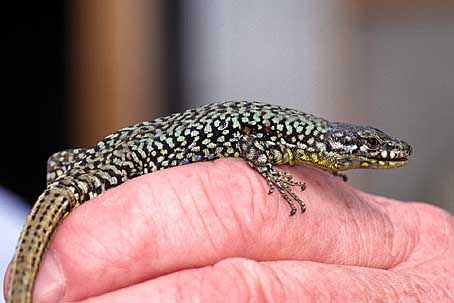 |
|
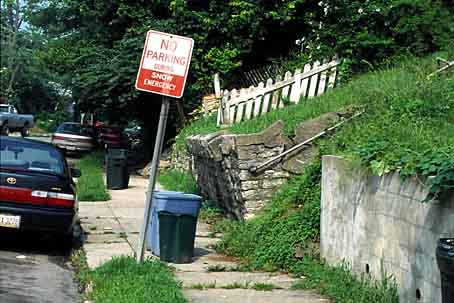 |
|
Male Podarcis m. maculiventris from Cincinnati, Ohio, USA in May 2000. Ca. 10 Common Wall Lizards were released in a south-eastern part of the city in the year 1951. Since then they have expanded continuously, occupying an area of ca. 6 km² in the year 2000. Railroad lines are used as spontaneous expanding corridors. Deliberate release by owners of private gardens, also in Kentucky on the south side of the Ohio river, are the continuing main reason for further expanding.
|
In inner parts of the occupied area numbers are in decline as a consequence of urban development. For instance, dry walls are replaced by concrete walls.
|
A hitherto disregarded document
As a reaction to one of the newspaper articles, a member of the Lazarus family, George Rau, wrote a letter to one of us (DG; letter on file at the Cincinnati Museum of Natural History) on 29 June 1989 in which he stated that, as a child, he was the one who brought approximately ten speciments of P. muralis to Cincinnati from Lake Garda in the northern lake section of Italy in 1951 or 1952. As part of a study investigating the status of European lacertids introduced in the USA (Deichsel and Miller 2000), GD gained access to this letter during a recent visit to Cincinnati. A review of the letter prompted an assessment of its contents from the perspective of European herpetology and the writing of the present article. In what follows, we list the key statements in the letter followed by our comments.
Approximately ten specimens of the P. muralis, obtained from Lake Garda, Italy were released by George Rau at his parental home on Torrence Court in eastern Cincinnati in September 1951 or 1952. About 1958, he released at the same location another ten lizards with "an absolutely solid blue stomach" obtained from the small island of Vedr√° off the southwest coast of Ibiza, Spain. He further states that as a consequence of interbreeding between these two groups, progeny with a series of blue spots on the venters resulted. To support this conclusion, he states that he had never observed lizards with blue spots on the venters prior to releasing the ten specimens from Vedr√°.
Despite the passage of time, we attribute a higher credibility to the first person statement of Rau that approximately 10 lizards were released in Cincinnati over second-hand accounts that two lizards were released (Hedeen 1984; Hedeen and Hedeen1999). The collection site of the first group of lizards in the vicinity of Lake Garda, about 120 km from Milan, Italy, identifies their sub-specific status as that of the nominate form, Podarcis muralis muralis. Judging from their origin, the second group of lizards released by Rau is Podarcis pityusensis vedrae, a cyanistic subspecies of the Ibizan wall lizard (Salvador 1986). The home archipelago of P. pityusensis is well separated from the natural range of P. muralis. Further, analysis of mitochondrial DNA of Podarcis (Harris and Arnold 1999) places these two species in different lineages within the genus. In addition, P. muralis does not interbreed with a sister species, P. sicula. Thus, the likelihood of Cincinnati P. muralis interbreeding with P. pityusensis seems remote but could be confirmed by DNA analysis.
It is unlikely that Podarcis p. vedrae survived in Cincinnati. This lizard normally lives on two small Mediterranean islands (Vedrá <0.5 km²., Vedranell <0.2 km²) whose maritime climate differs greatly from Cincinnati's continental climate. Like other subspecies of P. pityusensis from small islands, P. p. vedrae does not hibernate in the winter and is hence not likely to endure the more severe Cincinnati winters. Dietary factors also may have contributed to their extirpation. Approximately 50% of the diet of a comparable subspecies of P. pityusensis is plant material. Salvador (1986) reports that stomachs of P. p. karlkochi, a denizen of the neighboring small island of Conillera, contained almost 40% flowers in the month of January. If the diet of P. p. vedrae is similar to its con-subspecifics from small islands, then absence of a continuing plant-based food supply during the winter may have contributed to its demise.
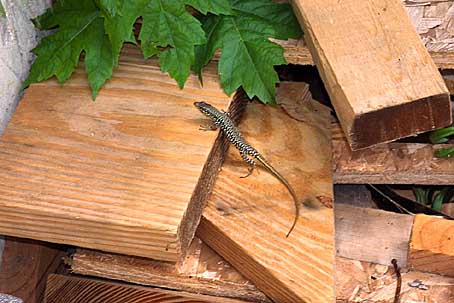 |
|
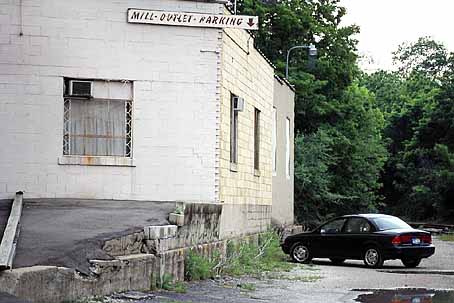 |
|
Refuse piles of wood are preferred interim habitats during building activities.
|
At this older building with its cracked walls, situated in the vicinity of an industrial railroad track, a reproducing colony of Wall Lizards established.
|
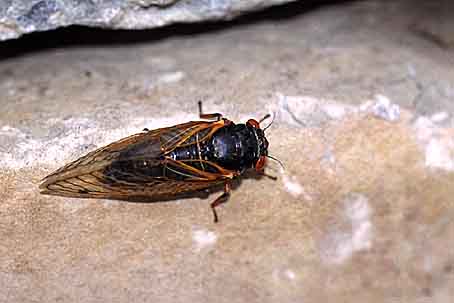 |
|
Seventeen-year-cicada, Magicicada septendecim , at a dry wall. The life cycle of this insect usually lasts 17 years. The emergence of the year 2000 was two years too early. Global warming is being discussed as the reason for this phenomenon. I could observe how freshly molted cicadas, still soft-shelled, were hunted and eaten by wall lizards. |
|
|
|
A comment on ventral color polymorphism
Ventral coloration of P. muralis warrants further consideration because it is subject to conspicuous variation, ranging from white, greyish, yellow and orange, to red. Such variation is known even in small, isolated Europen populations (Dexel 1986) and is reflected in the Cincinnati population. Brown (pers. comm.) investigated a sample of 77 lizards with 88% white, 7% yellow and 5% red venters, but was unable to correlate ventral color polymorphism of the Cincinnati Podarcis with allelic variations at 14 allozyme loci. He attributed the absence of allozyme variation to a founder effect, and the results remain unpublished. It is likely that the blue spots on the belly noted by Rau were actually on the flanks. These spots are particularly pronounced on males, and the intensity of these spots is subject to individual, seasonal, and sexual variation (Gruschwitz and Boehme 1986).
Conclusion
As the result of a letter written by one of the individuals involved in the introduction of common wall lizards to Cincinnati, Ohio, we believe we have evidence that the Cincinnati population of P. muralis, now covering more than 6 km², originated from ten specimens introduced by George Rau approximately fifty years ago. This information may be useful for researchers analyzing genetic variability in this isolate. The introduced lizards originated from Lake Garda, ca. 120 km distant from Milan, Italy. This location identifies the subspecific status as that of the nominate form, Podarcis muralis muralis. Another group of lizards introduced by Rau was identified as P. pityusensis vedrae and did not survive.
Note: The occurrence of Podarcis muralis in NW Ohio mentioned in this article proved to be based on a misidentification of a single specimen of Darevskia valentini, see Deichsel (2004)
Note (2005): After recent molecular analyses the subspecies of the Cincinnati Podarcis muralis population is to be changed to Podarcis muralis maculiventris. Sequences are deposited at GenBank under the accession number AY194855.
Acknowledgements
We wish to express our sincere thanks to the following persons: Carolin Bender provided general information on Podarcis muralis and made useful comments on the manuscript. Rafe Brown, Jeffrey Davis and John Ferner contributed details on the Podarcis population in and around Cincinnati. The comments of two reviewers improved the quality of this paper.
Literature Cited
ARNOLD E.N., and J. A. BURTON 1978. A Field Guide to the Reptiles and Amphibians of Britain and Europe. Collins, London, 272 pp.
BROWN R. M., D. H. GIST and D. H. TAYLOR. 1995: Home range ecology of an introduced population of the European wall lizard Podarcis muralis (Lacertilia: Lacertidae) in Cincinnati, Ohio. Am. Midl. Nat. 133:344-359.
_______, D. H.TAYLOR and D. H. GIST 1995: Effect of caudal autotomy on locomotor performance of wall lizards (Podarcis muralis). J. Herpetol. 29:98-105.
CONANT R. and T. COLLINS 1998. Peterson Field Guide to Reptiles and Amphibians of Eastern and Central North America. Third edition expanded. Houghton Mifflin Company, Boston. 616 pp.
DEICHSEL G., and L. L. MILLER 2000. Change of specific status for the Green Lacerta, an alien lizard introduced in Topeka. Kans. Herp. Soc. Newsl. No. 119:10-11.
DEXEL R. 1986. Zur Oekologie der Mauereidechse Podarcis muralis (Laurenti, 1768) (Sauria: Lacertidae) an ihrer noerdlichen Arealgrenze. Salamandra 22(1):63-78.
DRAUD M. and J. FERNER 1994. Podarcis muralis (Common Wall Lizard) Herpetol. Rev. 25(1):33.
ECKBERG J. 1989. Reptile's days slithering away. The Cincinnati Enquirer, June 24:C1-C2.
GRUSCHWITZ M. and W. BOEHME 1986: Podarcis muralis (Laurenti, 1768) - Mauereidechse In: W. Boehme (ed.), Handbuch der Reptilien und Amphibien Europas.Vol. 2/II. Aula-Verlag, Wiesbaden. 434 pp.
HARRIS D. J., and E. N. ARNOLD 1999. Relationships of wall lizards, Podarcis (Reptilia: Lacertidae) Based on Mitochondrial DNA Sequences. Copeia 1999:149-154.
HEDEEN S. E: 1984. The establishment of Podarcis muralis in Cincinnati, Ohio. Herpetol. Rev. 15:70-71.
_______, and D.L. HEDEEN 1999. Railway-aided dispersal of an introduced Podarcis muralis Population. Herpetol. Rev. 30:57-58.
KWAIT G.A., and D.H. GIST 1987. Annual reproductive cycle of an introduced population of European wall lizards (Podarcis muralis) in Ohio. Journ. Herpetol. Vol 21: 205-209.
VIGLE G.O. 1977. The history and distribution of an introduced population of Lacerta muralis (Reptilia, Sauria, Lacertidae) in Cincinnati, Ohio. Herp. Rev. 8(3)(Suppl.): 19.
SALVADOR A. 1986. Podarcis pityusensis (Bosc√°, 1883) - Pityusen-Eidechse. In: W. Boehme (ed.), Handbuch der Reptilien und Amphibien Europas.Vol. 2/II. Aula-Verlag Wiesbaden . 434 pp.
SNYDER S. 1993. Lazarus lizards. Cincinnati Magazine, May: 96-97.
"Letter by the person who released Podarcis in Cincinnati in the 1950ies"



